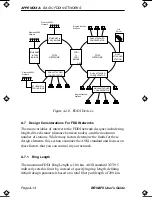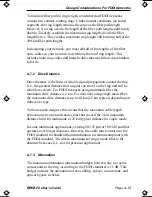
APPENDIX A: BASIC FDDI NETWORKS
Page A-12
BRIM-F6 User’s Guide
Optical bypass switches, concentrators, and bridges exist throughout
FDDI networks. These devices allow creation of ring topologies that meet
the specific needs of different network applications.
Repeaters, often found in other network topologies, do not exist as entities
for FDDI networks. This is because all devices that attach to the FDDI
main ring must comply with FDDI protocol. In other words, they must
dual attach to the ring and have, as a minimum, two PMD and PHY
entities and one MAC and SMT entity.
Since a DAS or DAC can match this configuration, either could serve as a
repeater when a main ring segment must extend beyond the 2 km
maximum between nodes.
Together with Figure A-10, the following descriptions provide a brief
introduction to several FDDI components and their network functions. In
many cases, specific functions combine in a single device.
An optical bypass switch allows insertion between a station and the
FDDI ring connections without having to remove the station from the ring
and disturbing ring continuity. These devices, often electrically actuated,
provide passive optical switching of both the primary and secondary ring
cables. Figure A-9 shows the data paths through the switch in both the
bypass and operational (non-bypassed) states.
BRIM-F Book Page 12 Monday, January 29, 1996 9:26 AM






































